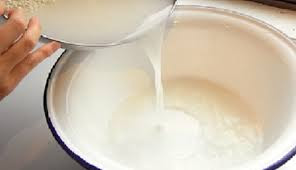Awaited not appear too interest.?
For a long time why do not bear fruit?
Perhaps one reason is the lack of fertilization ..
Lazy to buy fertilizer.?
Because it needs a little bit and just for potted plants or a few plants in the yard.
ok we try to peel of fertilizers and nutrients are easy to get around us, even if not yet able to replace the need for crops such as fertilizer manufacturer, origin of more regular and diligent in giving, the many possibilities that could meet our plants ..
Immediately, we discussed materials that can replace existing fertilizer around us are:
Waste water from washing rice
Instead of rice water thrown away, I always use it for watering plants in pots or in the yard. Do not contact the leaves yes because it will make the white spots on the leaves. Enough pour directly on the ground.
When you wash the rice, wash water is usually the first to be cloudy. Used washing muddy color indicates that the outermost layer of rice participated eroded. Although many of the nutrients that have been lost, but in the epidermis there are still remnants of the nutrients that are beneficial. Suppose phosphorus (P), one of the main elements that plants need and is always present in compound fertilizer plants. Phosphorus plays a role in spurring the growth of the roots and the establishment of a good root system of seeds and young plants. Other nutrients are iron are important to the formation of leaf green (chlorophyll) also plays an important role in the formation of carbohydrates, fats and proteins. Besides epidermis also contains vitamins, minerals, and phytonutrients high. Vitamins are very instrumental in the formation of hormones and serves as a coenzyme (non-protein components to activate the enzyme).
Rice contain carbohydrates that are high. Very likely these carbohydrates degraded when washing. The initial hypothesis, when poured into the plant, carbohydrates are broken into simpler elements and provide nutrients for microbes that are beneficial to plants. Although I do not know what microbes are benefited by this leri water carbohydrate content. Interesting if no one has studied.
Latest facts is the result of research conducted Yayu Siti Nurhasanah IPB students. Revealed that the rice water is an alternative media carriers of the bacteria Pseudomonas fluorescens. Bacteria are microbes that play a role in controlling the disease-causing petogen rust and trigger the growth of plants (Legal, 19/10/11). Psedomonas fluorescens was instrumental in controlling rust disease-causing pathogens and trigger the growth of plants.
Water Tea
If you make tea last night and forgot to drink it. Do not waste it because the tea is very beneficial. One benefit can nourish plants. The way is to sprinkle the roots and the soil using the stale tea water.
Water stale tea contains carbohydrates, vitamin A, vitamin C, phosphorus, iron, copper, magnesium, tannin acid, manganese and caffeine. With nutrient content owned stale tea water as above water stale tea makes it able to improve soil fertility, stimulate the growth of roots, stems and leaves, household waste can be used directly without further processing. Besides water stale tea also are toxic to insects of plants, if the stale tea water is used as a compost. Water stale tea contains many good nutrients for the soil. Microbes produced by stale tea water is only toxic to insects in plants so that the plants do not have to worry about toxic and dangerous for human consumption (kusnadi, 2003).
This is an existing concentration of plant nutrients in tea water (waste water that has not drunk tea), including:
The concentration of nutrients:
Calories (mg) 132, Fat (mg) 0.79, Water (g) 7.6, Protein (mg) 19:59, carbohydrates (mg) 67.89, Vitamin A (SI) 2095, Vitamin B (mg) 0.01, Vitamin C (mg) 300, Phosphorus (mg) 265, Iron (mg) 11.8
Organic carbon is not certain Copper (%) 20 Magnesium (%) 10 Potassium (%) 13 Calcium (mg) 717, 10-25 polyphenols.
methylxanthines in few amino acids Little Tannin acid (%) 9-20, Selenium (ppm%) from 1 to 1.8, Manganese (ug / ml) 300-600, Caffeine (mg%) 45-50
With nutrient content owned stale tea water as above water stale tea makes it able to improve soil fertility, stimulate the growth of roots, stems and leaves, household waste can be used directly without further processing.
Besides water stale tea also are toxic to insects of plants, if the stale tea water is used as a compost. Water stale tea contains many good nutrients for the soil. Microbes produced by stale tea water is only toxic to insects in plants so that the plants do not have to worry about toxic and dangerous for human consumption.
Coffee Grounds
If you like to drink coffee, do not discard the waste. Coffee grounds rich in Nitrogen, Phosphorus and Potassium that plants need. Thus released by soil and plant laboratory inc California United States. Therefore coffee grounds scatter around the roots of plants and vegetables in the pot. Nutrient content in coffee grounds decompose slowly.
Coffee grounds is an organic fertilizer that is economical and environmentally friendly. Spent coffee grounds contain 2.28% nitrogen, 0.06% phosphorus and 0.6 potassium. pH is slightly acidic coffee grounds, ranging from 6.2 on the pH scale. In addition, the coffee grounds containing magnesium, sulfur and calcium which is useful for plant growth.
Also there are many alternatives for crop nutrients us, for those lovers of organic crops will be more value to be used for crops, especially not so hard to get it.
So a little review of plant nutrients that are around us, hopefully this article can be useful to readers.
